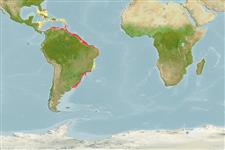>
Eupercaria/misc (Various families in series Eupercaria) >
Sciaenidae (Drums or croakers)
Etymology: Micropogonias: Greek, mikros = small + greek, pogon = beard (Ref. 45335).
Eponymy: Marcellin Fournier supplied specimens from Cuba. For some reason, Desmarest chose to omit the o from Fournier’s name in the scientific binomial furnieri. We have been unable to unearth any further information. (Ref. 128868), visit book page.
Issue
The species Micropogonias opercularis (Quoy & Gaimard, 1825) is considered as valid in Eschmeyer (CofF ver. Jul. 2010: Ref. 84883) according to López et al. (2002: Ref. 80900).
Environment: milieu / climate zone / تغييرات عمق / distribution range
بوم شناسي
دريايي; لب شور نزديك كف زي; اقیانوس رو (Ref. 51243); تغييرات عمق ? - 60 m (Ref. 9626), usually 20 - 40 m (Ref. 9626). Subtropical; 27°N - 36°S, 84°W - 34°W (Ref. 54591)
Western to Southwest Atlantic: Greater Antilles and from Costa Rica to Argentina (Ref. 9626). Also reported in Nicaragua (Ref. 13613). Also reported in Brazil (Ref. 118626).
Length at first maturity / Size / Weight / سن
بلوغ: Lm 30.6 range ? - ? cm
Max length : 60.0 cm SL جنس نر / بدون خواص جنسي; (Ref. 27363); common length : 45.0 cm SL جنس نر / بدون خواص جنسي; (Ref. 27363); بيشينه وزن گزارش شده: 55.30 g (Ref. 118626); بيشينه سن گزارش شده: 7 سال ها (Ref. 27)
خارهاي باله پشتي (کل) : 11; شعاع نرم باله پشتي (کل) : 26 - 30; خارهاي باله مخرجي: 2; شعاع نرم باله مخرجي: 7 - 9. Body silvery with a golden cast, back greyish, with distinct oblique dark streaks along scale rows extending to much below lateral line; spinous dorsal without small dark dots (Ref. 27363).
Body shape (shape guide): short and / or deep.
Found over muddy and sandy bottoms in coastal waters and in estuaries where the nursery and feeding grounds are located. Adults form schools. Feeding habits vary with ontogenic development and season; juveniles feed on benthic migratory crustaceans and sessile boring mollusks while adults are benthos-feeders and occasionally capture fish (Ref. 27). Undergoes seasonal migration. An important food fish which is usually marketed fresh and salted.
Life cycle and mating behavior
بلوغ | تولید مثل | تخم ریزی | تخم ها | Fecundity | توزاد ( لارو)
Isaac, V.J., 1988. Synopsis of biological data on the whitemouth croaker, Micropogonias furnieri (Desmarest, 1823). FAO Fish. Synop. (150). (Ref. 27)
وضعيت در فهرست قرمز IUCN (Ref. 130435: Version 2025-1)
خطر برای انسان ها
Harmless
استفاده انسانی
ماهي گيري – شيلات: با ارزش تجاري بالا
ابزارها
گزارش های ويژه
بارگيری XML
منابع اينترنتي
Estimates based on models
Preferred temperature (مرجع
123201): 16.5 - 28, mean 26.6 °C (based on 196 cells).
Phylogenetic diversity index (مرجع
82804): PD
50 = 0.5156 [Uniqueness, from 0.5 = low to 2.0 = high].
Bayesian length-weight: a=0.00933 (0.00773 - 0.01127), b=3.02 (2.96 - 3.08), in cm total length, based on LWR estimates for this species (Ref.
93245).
Trophic level (مرجع
69278): 3.1 ±0.1 se; based on diet studies.
Generation time: 6.1 (4.3 - 8.5) years. Estimated as median ln(3)/K based on 12
growth studies.
جهندگی (مرجع
120179): متوسط, كمينه زمان لازم براي دو برابر شدن جمعيت 4/1 – 4/4 سال (K=0.12-0.18; tmax=7).
Prior r = 0.71, 95% CL = 0.47 - 1.06, Based on 4 data-limited stock assessments.
Fishing Vulnerability (Ref.
59153): Moderate to high vulnerability (48 of 100).
🛈
Climate Vulnerability (Ref.
125649): Moderate vulnerability (43 of 100).
🛈
Nutrients (Ref.
124155): Calcium = 82.4 [47.1, 158.8] mg/100g; Iron = 1.07 [0.58, 1.86] mg/100g; Protein = 20 [18, 22] %; Omega3 = 0.265 [0.134, 0.513] g/100g; Selenium = 28.3 [15.5, 53.0] μg/100g; VitaminA = 7.34 [2.76, 23.48] μg/100g; Zinc = 0.86 [0.63, 1.26] mg/100g (wet weight); based on
nutrient studies.
